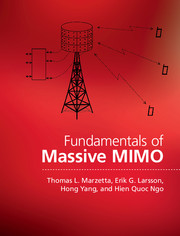Refine search
Actions for selected content:
3527 results in Wireless Communications
7 - The Massive Mimo Propagation Channel
-
- Book:
- Fundamentals of Massive MIMO
- Published online:
- 03 November 2016
- Print publication:
- 17 November 2016, pp 139-156
-
- Chapter
- Export citation
Index
-
- Book:
- Fundamentals of Massive MIMO
- Published online:
- 03 November 2016
- Print publication:
- 17 November 2016, pp 223-225
-
- Chapter
- Export citation
2 - Models and Preliminaries
-
- Book:
- Fundamentals of Massive MIMO
- Published online:
- 03 November 2016
- Print publication:
- 17 November 2016, pp 19-44
-
- Chapter
- Export citation
7 - Dedicated Wireless Energy Harvesting in Cellular Networks: Performance Modeling and Analysis
- from Part II - Architectures, Protocols, and Performance Analysis
-
-
- Book:
- Wireless-Powered Communication Networks
- Published online:
- 01 December 2016
- Print publication:
- 17 November 2016, pp 246-264
-
- Chapter
- Export citation
G - Uniformly Distributed Points in A Hexagon
-
- Book:
- Fundamentals of Massive MIMO
- Published online:
- 03 November 2016
- Print publication:
- 17 November 2016, pp 207-208
-
- Chapter
- Export citation
6 - Backscattering Wireless-Powered Communications
- from Part II - Architectures, Protocols, and Performance Analysis
-
-
- Book:
- Wireless-Powered Communication Networks
- Published online:
- 01 December 2016
- Print publication:
- 17 November 2016, pp 217-245
-
- Chapter
- Export citation
Preface
-
- Book:
- Fundamentals of Massive MIMO
- Published online:
- 03 November 2016
- Print publication:
- 17 November 2016, pp 1-4
-
- Chapter
-
- You have access
- Export citation
4 - Cooperative Networks with Wireless Energy Harvesting
- from Part II - Architectures, Protocols, and Performance Analysis
-
-
- Book:
- Wireless-Powered Communication Networks
- Published online:
- 01 December 2016
- Print publication:
- 17 November 2016, pp 135-169
-
- Chapter
- Export citation
Preface
-
- Book:
- Wireless-Powered Communication Networks
- Published online:
- 01 December 2016
- Print publication:
- 17 November 2016, pp xi-xiv
-
- Chapter
- Export citation
10 - Cognitive Radio Networks with Wireless Energy Harvesting
- from Part III - Applications of Wireless Energy Harvesting and Transfer
-
-
- Book:
- Wireless-Powered Communication Networks
- Published online:
- 01 December 2016
- Print publication:
- 17 November 2016, pp 338-382
-
- Chapter
- Export citation

Fundamentals of Massive MIMO
-
- Published online:
- 03 November 2016
- Print publication:
- 17 November 2016
12 - Antenna Integration
-
- Book:
- Radio Systems Engineering
- Published online:
- 28 May 2018
- Print publication:
- 06 October 2016, pp 363-396
-
- Chapter
- Export citation
9 - Impedance Matching
-
- Book:
- Radio Systems Engineering
- Published online:
- 28 May 2018
- Print publication:
- 06 October 2016, pp 259-284
-
- Chapter
- Export citation
16 - Frequency Synthesis
-
- Book:
- Radio Systems Engineering
- Published online:
- 28 May 2018
- Print publication:
- 06 October 2016, pp 486-515
-
- Chapter
- Export citation
10 - Amplifiers
-
- Book:
- Radio Systems Engineering
- Published online:
- 28 May 2018
- Print publication:
- 06 October 2016, pp 285-337
-
- Chapter
- Export citation
6 - Digital Modulation
-
- Book:
- Radio Systems Engineering
- Published online:
- 28 May 2018
- Print publication:
- 06 October 2016, pp 139-202
-
- Chapter
- Export citation
Preface
-
- Book:
- Radio Systems Engineering
- Published online:
- 28 May 2018
- Print publication:
- 06 October 2016, pp xxxix-xlii
-
- Chapter
- Export citation
Appendix B - Characteristics of Some Common Radio Systems
-
- Book:
- Radio Systems Engineering
- Published online:
- 28 May 2018
- Print publication:
- 06 October 2016, pp 583-595
-
- Chapter
- Export citation
2 - Antenna Fundamentals
-
- Book:
- Radio Systems Engineering
- Published online:
- 28 May 2018
- Print publication:
- 06 October 2016, pp 16-59
-
- Chapter
- Export citation
References
-
- Book:
- Radio Systems Engineering
- Published online:
- 28 May 2018
- Print publication:
- 06 October 2016, pp 596-599
-
- Chapter
- Export citation
